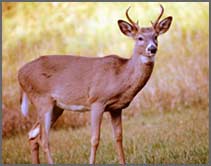Biosphere Contents
4. Interdependence
It has been argued that the story of the Kaibab deer herd in Arizona shows a catastrophic population crash in the absence of natural predators

In the early 1900s the deer herd on the Kaibab Plateau (north of the Grand Canyon in Arizona) numbered around 4,000 head. In 1907 a bounty was placed on cougars, wolves and coyotes, all of which were natural predators to the deer. The numbers of these predators fell substantially, coinciding with rapid growth in the number of deer. By 1918 the deer population had increased almost ten fold. In the absence of any natural predators, and with hunting banned, the herd reached an estimated 100,000 head by 1924, and overgrazing placed an impossible demand on their food resources. Ultimately, these resources became so scarce that 60% of the herd died off in two successive winters. Even under the reduced pressure the vegetation that the deer relied on failed to regenerate adequately and by 1939 the herd had reduced in size to around 10,000 individuals.
Why might the kaibab deer diminish in the absence of natural predators?